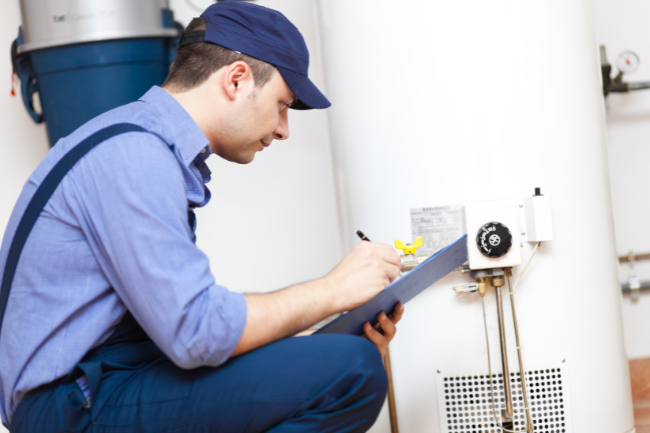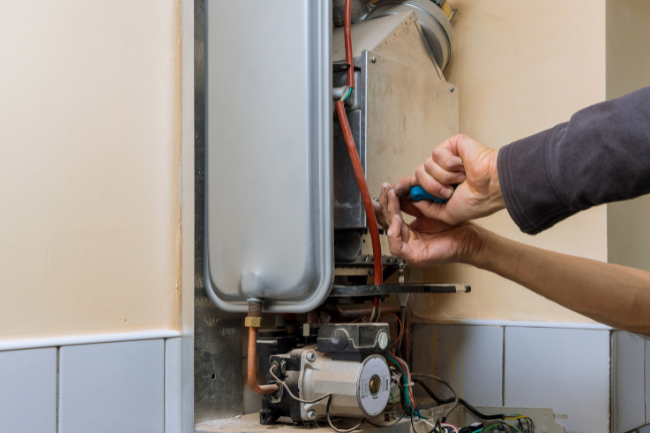5 Easy Steps For a DIY Water Heater Thermostat Repair
Posted by William Heinselman on

Hot water is a luxury that most of us can't live without. Think about all the different ways you use hot water in your day-to-day life – washing dishes, washing clothes, bathing, mopping, etc.
If your household water heater stops working, you'll have an idea of just how important and valuable your water heater is to your daily routine and lifestyle.
There are a couple of different types of water heaters – electric and fuel, or gas. Each works a little differently, yet they both serve the same functions including heating water and storing hot water until it's ready to be used.
A water heater's thermostat is the most commonly damaged or interrupted part of either water heater.
When a water heater's thermostat breaks, you won’t be able to gauge or set the temperature of your hot water. Maintaining the integrity of the thermostat is important for keeping your water from reaching scalding temperatures.
When Should You Repair Your Water Heater Thermostat?
There are a few tell-tale signs that you should pay attention to when it comes to your water heater. Some of the signs below may be an indicator that your water heater should be repaired.
Inconsistencies in Water Temperature
One of the most noticeable and frustrating issues you might encounter with your water heater is the sudden fluctuation in water temperature. These unpredictable changes can be more than just an inconvenience; they can also indicate underlying problems with your water heater's thermostat or heating elements.
Such inconsistencies might be caused by a malfunctioning thermostat that fails to regulate the temperature properly, or it could be due to sediment buildup in the tank, which affects the heater's efficiency. Additionally, external factors like fluctuating water pressure or issues with the power supply can also contribute to these temperature swings. Addressing these inconsistencies promptly is crucial to ensure a comfortable and safe water temperature in your home.
Your Water is Too Hot
Water that is too hot is a big indicator that your thermostat is set too high. Other external factors such as seasons may contribute to this problem, and you should change the recommended setting according to the transition from cold to warm weather.
If you can't lower the temperature of your water, you may need to replace the entire thermostat or check for any wiring issues.. Find a professional to help you fix thermostat wiring issues to avoid injury or further damage.
There's Not Enough Hot Water
Not enough hot water can also be caused by cold weather temperatures. You may have cold pipes that aren't insulated, or you may have a broken thermostat. Some other possible issues may include loose wiring, faulty parts, or the hot water tank is too small for your usage needs.
Water Takes Too Long to Reheat
Electric water heaters typically take a long time to reheat. The time it takes an electric heater to reheat is double the time it takes for a gas heater.
If you find that it is taking even longer to heat, there may be a problem with the heating elements or thermostat.
A Step-by-Step Guide to Repair a Water Heater Thermostat

The thermostat regulates the temperature of the water in a water heater. If the temperature is set too low, then the water will cool prior to distributing to the faucet. Likewise, if the temperature is set too high, then you could risk burning or scalding water temperature released from the faucet.
Here's how to fix a thermostat if you have no hot water:
-
Locate the upper and lower thermostats.
-
Check both thermostats for power supply.
-
Press the button to reset the thermostat to determine whether it will or won’t operate.
-
Replace the thermostat if there is no power to the upper system.
-
If your upper system is receiving power but there is no hot water, then replace the upper heating element.
If your water temperature isn't right, you can easily adjust the thermostat. Here are three easy steps for Sacramento residents to follow.
1. Locate Your Water Heater’s Temperature Control Knob.
The temperature control knob is connected to its heat source which is typically red and located on the front, lower center portion of the heater.2. Look for the Small Black Line or Arrow above the Knob.
This is where the current temperature is set and the setting may be labeled “warm” or “hot.” This can also be labeled by a black line (120 degrees Fahrenheit) or a white line (105-110 degrees Fahrenheit).
3. Adjust the Temperature Somewhere Between 105 and 120 Degrees Fahrenheit.
When to Repair or Replace A Water Heater Thermostat
How do you know whether to repair or replace your water heater? Generally, if it’s not a leak, then the damage is manageable and can typically be easily repaired. For instance, tank wear or rust are the most common damages you’ll notice with your water heater. These issues are typically things that can be repaired.
If your tank is leaking, then it is better for you to replace it rather than repair it. This is because there are no adequate repair options for a failing tank. Leaking tanks can also cause harmful water damage to your personal items, and when the water isn't cleaned up mold-breeding fungi can grow.
Here are some other factors that may cause water heater issues:
- The drain valve
- The cold water inlet
- A sacrificial anode rod
- A dip tube
- A pressure relief valve
Call Express Sewer for Water Heater Repair or Replacement
If you are having trouble with your water heater in the Sacramento area, then contact your local expert to determine if it should be replaced or repaired. By consulting with a specialist, like Express Sewer and Drain, you can ensure that your water heater is functioning efficiently and safely, preventing further complications or potential damage to your home.
Topics: Water Heaters






